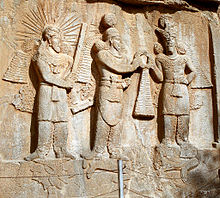Yazata
Yazata ( Avestan , "venerable" ( Sg. ); From the yaz tribe : "worship", "praise", "offer sacrifice"; corresponding to Middle Persian Yazd and plural Yazdân , from this New Persian Izad : "God" / "Deity" and Yazdân : "God") in the narrower sense denotes Zoroastrian Iranian deities. In the Avesta , the sacred book of the Zoroastrians , the term refers to deities who are subordinate to the Creator, Ahura Mazda , and who contribute to his work, but also to outstandingly truthful and righteous people, who in the sense of the Asha principle are higher Stages of human development have reached. Here Ahura Mazda ( Pahlavi : Ohrmazd ) is the highest figure among the divine Yazatas, while Zarathustra occupies the highest position among the worldly. In the hierarchy of deities, Ahura Mazda is followed by Amesha Spenta (Pahlavi: Amahraspand , Neupersian: Amšâspand ).
The deities appearing under the name Yazata represent to a considerable extent considerably older, pre-orastrian Iranian deities, which, however, were later subjected to a Zoroastrian conceptualization.
In a broader sense, the term Yazata is reflected in younger deities of the Iranian pantheon , in particular in figures of Manichaeism , which in Middle Persian can be found in the work Šābuhragān of the prophet Mani . The deity Mithra (Avestian: Mithra , Middle Persian: Mihr ) appears in Middle Persian Manichaean designation and meaning as "Yazad" "Mihr".
Among the Yazatas, the following are particularly important, which is manifested, among other things, by their presence in the Zoroastrian calendar and partly in the Iranian calendar :

- Ahura Mazda
- Vohu Manah
- Aša vahišta
- Xšathra vairya
- Spenta armaiti
- Haurvatat
- Ameretat
- Atar
- Apam Napat
- Hvare Xšaēta
- Mavangh
- Tishtrya
- Geush Urvan
- Mithra
- Sraosha
- Rashnu
- Fravashi
- Verethragna
- Rama
- Vada
- Daena
- Ashi
- Ashtad
- Asman
- Zam
- Manthraspenta
- Anagran
We already encounter the term Yazata in the Gathas of Zarathustras. Here they appear as opposed and venerable powers to the Daevas , who are invoked as a whole. In later sections of the Avesta they finally appear as individual deities, some of which are depicted in anthropomorphic form. For example, the book Visperad reveals devotional praises and hymns of praise to various deities, to which Vohu Manah and Anahita belong, among others .
In the Achaemenid Empire , a deity was dedicated to each day of the calendar month and was commemorated in particular. At the same time, every day of the month was expressly placed under the protection of a deity. The resulting tradition is reflected in the Zoroastrian and partly in the Iranian calendar.
See also
literature
- Jalil Doostkhah. Avesta . Translation of the text. Morvarid, Tehran, 1996. ISBN 964-6026-17-6 .
- Mary Boyce . Zoroastrians. Their Religious Beliefs and Practices . Routledge, 2008. ISBN 978-0-415-23903-5 .
- Mary Boyce. "On Mithra in the Manichaean Pantheon" in: Walter B. Henning and Ehsan Yarshater, A Locust's Leg: Studies in Honor of SH Taqizadeh , London, 1962, pages 44-54.
- Hashem-e Razi. Encyclopaedia of Ancient Iran . Sokhan, Tehran, 2002. ISBN 964-372-027-6 .
- DN MacKenzie. A Concise Pahlavi Dictionary . Routledge Curzon, 2005. ISBN 0-19-713559-5 .
- DN MacKenzie; Mani. Mani's "Sabuhragan" . Bulletin of the School of Oriental and African Studies, University of London. Volume 42, No. 3, 1979.
- EW West. Pahlavi Texts. Translated by EW West . 5 volumes. Routledge Curzon, 1895-1910, 2004. ISBN 07007-1544-4 .
- Hashem-e Razi. Chronology & Ancient Iranian Festivals . Behjat, Tehran, 2004. ISBN 964-6671-37-3 .
- P. Oktor Skjærvø. Young Avestan Glossary . Harvard University.
- M. Mo'in. An Intermediate Persian Dictionary. Six volumes . Amir Kabir Publications, Tehran, 1992.